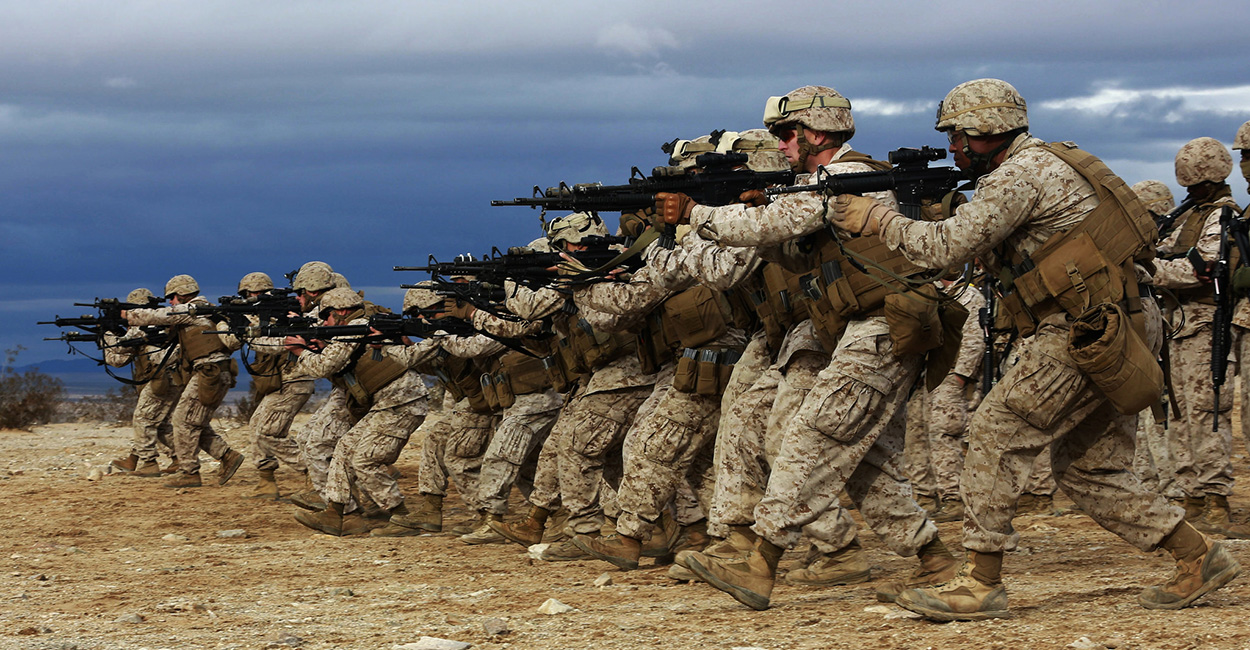
U.S. Marines practice "combat gliding" during an Integrated Training Exercise 2-15 at Camp Wilson in California. (Photo: U.S. Marine Corps photo by Lance Cpl. Kathryn Howard/Released)
In one of his first actions as secretary of defense, Ashton Carter met over the weekend with top U.S. officials to determine a path forward in the fight against ISIS. While threats have clearly grown, the president has sought to shrink military capability.
This radical Islamic group has increasingly shown the gruesome lengths it is willing to go to achieve its goals, and has also shown a knack for expanding its reach with atrocities such as a recent mass execution of Egyptians in Libya.This alone is enough to consume much of the defense secretary’s time and effort, but it is only one of the threats the United States faces all over the globe.
Stability in Yemen has almost completely collapsed. Russia continues to push further into Ukraine. Tension mounts between China and its neighbors over territorial disputes. With these growing threats around the globe, the challenges facing the U.S. military are daunting.
One would think this has inspired the White House and Congress to take their commitments to national security more seriously, but the opposite has actually occurred over President Obama’s tenure as commander-in-chief. While threats have clearly grown, the president has sought to shrink military capability. Congress has followed this with spending cuts such as those required by sequestration.
It’s clear that policymakers aren’t fully understanding their constitutional responsibility to provide for the common defense.One possible reason politicians have failed to maintain the strength of the U.S. military is because they have misunderstood what problems our security posture is facing.
Before looking at what programs to dedicate more or fewer taxpayer dollars to each year, the executive and legislative branches should be asking the following question: What does the United States need to defend its security and interests at home and abroad in a constantly changing political and global escape?
That’s a question that Congress, the American public, defense analysts and even the military are challenged to determine the correct answer to.One reason for that is while many publications assess pieces of the security puzzle, there is no consistent, accessible reference that enables people to comprehensively understand the status of U.S. military, especially on a year-to-year basis.
Today, The Heritage Foundation releases its first-ever Index of U.S. Military Strength.[see link below.] This publication assesses in a new way America’s ability to uphold one of its primary Constitutional responsibilities—to provide for the common defense.
We see as central to all U.S. military activity the protection of three critical interests: safeguarding the homeland from external attack, preventing a major power threat in key regions that would be devastating to U.S. interests, and maintaining the freedom of the commons, or the sea, air, space, and cyberspace that facilitate the free flow of goods and services.
The index provides insights on the threats and opportunities around the world, as well as the direction our military is headed in terms of providing for our security. Here are a few of the broad findings of the index:
[1] America’s allies, though stable, are less capable than before, in part because many of them have also lost sight of maintaining robust security forces. This means the U.S. will be less able to rely on its allies for military support.
[2] Nations and actors who pose a threat to the U.S. are growing in capability. America’s adversaries are investing in weapons and systems intended to achieve their goals that potentially threaten U.S. interests.
[3] The U.S. military is aging and shrinking in size, with a marginal ability to handle one major war and sustain other current presence and engagements around the globe. The armed forces are currently stretched to meet current demands, which in turn consume limited resources at the risk of the long-term health of the military.
[4] All these conditions are ripe for exploitation by competitors and enemies. These trends are worrisome—it is far easier to continue to decline than for Congress and the president to make hard decisions that could nevertheless rapidly improve U.S. military strength.
It has become increasingly clear that the world is not becoming a safer place. If the United States wishes to provide U.S. security and enable free societies and economic prosperity to flourish around the globe, the government needs to find a new path toward maintaining a strong national defense.
>>> Read the Index of U.S. Military Strength- http://index.heritage.org/militarystrength/
[bold and italics emphasis mine]
Brian Slattery is a research associate for Security Studies at The Heritage Foundation. In this capacity he advocates for a strong national defense and robust security enterprise. Brian focuses particularly on maritime security, the U.S. Coast Guard and the Arctic.






No comments:
Post a Comment